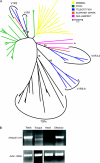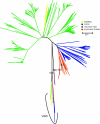Origin of the genetic components of the vomeronasal system in the common ancestor of all extant vertebrates
- PMID: 19008528
- PMCID: PMC2727394
- DOI: 10.1093/molbev/msn262
Origin of the genetic components of the vomeronasal system in the common ancestor of all extant vertebrates
Abstract
Comparative genomics provides a valuable tool for inferring the evolutionary history of physiological systems, particularly when this information is difficult to ascertain by morphological traits. One such example is the vomeronasal system (VNS), a vertebrate nasal chemosensory system that is responsible for detecting intraspecific pheromonal cues as well as environmental odorants. The morphological components of the VNS are found only in tetrapods, but the genetic components of the system have been found in teleost fish, in addition to tetrapods. To determine when the genetic components of the VNS originated, we searched for the VNS-specific genes in the genomes of two early diverging vertebrate lineages: the sea lamprey from jawless fishes and the elephant shark from cartilaginous fishes. Genes encoding vomeronasal type 1 receptors (V1Rs) and Trpc2, two components of the vomeronasal signaling pathway, are present in the sea lamprey genome, and both are expressed in the olfactory organ, revealing that the genetic components of the present-day VNS existed in the common ancestor of all extant vertebrates. Additionally, all three VNS genes, Trpc2, V1Rs, and vomeronasal type 2 receptors (V2Rs), are found in the elephant shark genome. Because V1Rs and V2Rs are related to two families of taste receptors, we also searched the early diverging vertebrate genomes for taste system genes and found them in the shark genome but not in the lamprey. Coupled with known distributions of the genetic components of the vertebrate main olfactory system, our results suggest staggered origins of vertebrate sensory systems. These findings are important for understanding the evolution of vertebrate sensory systems and illustrate the utility of the genome sequences of early diverging vertebrates for uncovering the evolution of vertebrate-specific traits.
Figures




Similar articles
-
Distinct evolutionary patterns between chemoreceptors of 2 vertebrate olfactory systems and the differential tuning hypothesis.Mol Biol Evol. 2008 Aug;25(8):1593-601. doi: 10.1093/molbev/msn107. Epub 2008 May 5. Mol Biol Evol. 2008. PMID: 18460446 Free PMC article.
-
Lamprey possess both V1R and V2R olfactory receptors, but only V1Rs are expressed in olfactory sensory neurons.Chem Senses. 2022 Jan 1;47:bjac007. doi: 10.1093/chemse/bjac007. Chem Senses. 2022. PMID: 35522082
-
Origin and evolution of the vertebrate vomeronasal system viewed through system-specific genes.Bioessays. 2006 Jul;28(7):709-18. doi: 10.1002/bies.20432. Bioessays. 2006. PMID: 16850401 Review.
-
Comparative genomic analysis identifies an evolutionary shift of vomeronasal receptor gene repertoires in the vertebrate transition from water to land.Genome Res. 2007 Feb;17(2):166-74. doi: 10.1101/gr.6040007. Epub 2007 Jan 8. Genome Res. 2007. PMID: 17210926 Free PMC article.
-
Evolution of V1R pheromone receptor genes in vertebrates: diversity and commonality.Genes Genet Syst. 2019 Oct 30;94(4):141-149. doi: 10.1266/ggs.19-00009. Epub 2019 Oct 2. Genes Genet Syst. 2019. PMID: 31474650 Review.
Cited by
-
Mutual influences between the main olfactory and vomeronasal systems in development and evolution.Front Neuroanat. 2012 Dec 24;6:50. doi: 10.3389/fnana.2012.00050. eCollection 2012. Front Neuroanat. 2012. PMID: 23269914 Free PMC article.
-
Structural requirements for the activation of vomeronasal sensory neurons by MHC peptides.Nat Neurosci. 2009 Dec;12(12):1551-8. doi: 10.1038/nn.2452. Nat Neurosci. 2009. PMID: 19935653
-
Molecular evolutionary characterization of a V1R subfamily unique to strepsirrhine primates.Genome Biol Evol. 2014 Jan;6(1):213-27. doi: 10.1093/gbe/evu006. Genome Biol Evol. 2014. PMID: 24398377 Free PMC article.
-
Chemical cues and pheromones in the sea lamprey (Petromyzon marinus).Front Zool. 2015 Nov 25;12:32. doi: 10.1186/s12983-015-0126-9. eCollection 2015. Front Zool. 2015. PMID: 26609313 Free PMC article. Review.
-
Coadaptation of the chemosensory system with voluntary exercise behavior in mice.PLoS One. 2020 Nov 25;15(11):e0241758. doi: 10.1371/journal.pone.0241758. eCollection 2020. PLoS One. 2020. PMID: 33237909 Free PMC article.
References
-
- Adler E, Hoon MA, Mueller KL, Chandrashekar J, Ryba NJ, Zuker CS. A novel family of mammalian taste receptors. Cell. 2000;100:693–702. - PubMed
-
- Arendt D. Evolution of eyes and photoreceptor cell types. Int J Dev Biol. 2003;47:563–571. - PubMed
-
- Arendt D, Tessmar-Raible K, Snyman H, Dorresteijn AW, Wittbrodt J. Ciliary photoreceptors with a vertebrate-type opsin in an invertebrate brain. Science. 2004;306:869–871. - PubMed
-
- Berghard A, Dryer L. A novel family of ancient vertebrate odorant receptors. J Neurobiol. 1998;37:383–392. - PubMed
Publication types
MeSH terms
Substances
Grants and funding
LinkOut - more resources
Full Text Sources

